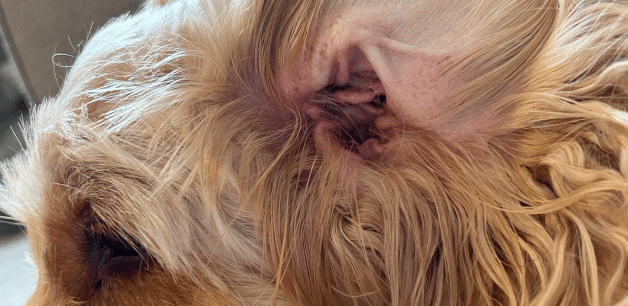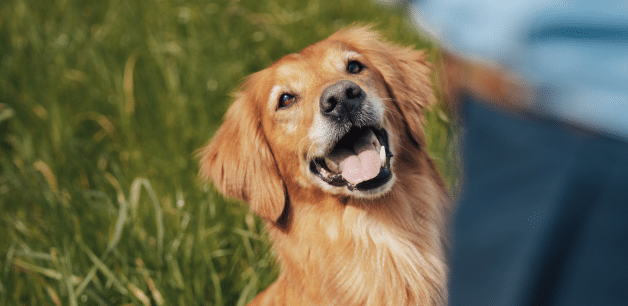Dog ear infections are a common problem for many dogs, especially during the warmer months. They can cause discomfort and irritation, and some dogs suffer from recurring yeast infections. Recognising symptoms early and managing them quickly can greatly improve your dog’s quality of life.
In this blog, I’ll cover the causes, symptoms, prevention, and how to treat yeast ear infections in dogs. I hope you find it useful!
Understanding a dog ear infection: Yeast or bacteria?
The cause of infections in dogs ears can be difficult to determine. Dog fungal ear infections often have a strong, musty odour, thick dark discharge, and intense itchiness. While bacterial infections may produce a bad smell, yellowish discharge, and potential crusting.
Dogs with long ears, such as Cocker Spaniels and Basset Hounds, are particularly prone to these infections due to reduced air circulation in the ear canal. As you can imagine, I’ve dealt with a fair few ear infections over the years with my floppy-eared pack! Here are some of the most common symptoms to look out for.

Symptoms of yeast ear infections
Early detection of a yeast ear infection can prevent more serious health issues. Look out for the following symptoms:
Itching and scratching: Your dog may scratch their ears frequently or shake their head.
Redness and swelling: The ear canal and surrounding area may appear red and swollen.
Discharge: A dark brown or yellow discharge with a distinct, unpleasant odour is a common sign, due to trapped moisture.
Pain and discomfort: Your dog may show signs of pain when you touch their ears.
Hearing loss: Severe infections can lead to temporary hearing loss.
Prevention strategies
A great way to prevent yeast infections involves regular ear care and addressing any underlying health issues. Here are some effective strategies:

Regular ear cleaning
Regularly clean your dog’s ears using a vet-recommended ear cleaner, such as Otodine. There are lots of other ear cleansers available too. If you haven’t done this before, here’s my step by step guide:
First, gently pull back your dog’s ear so that the ear canal is exposed.
Slowly fill the ear canal with the cleaning solution until it brims at the top of the ear canal. Your dog might fidget for this part, so having a second person there to help might be useful!
Gently massage the ear canal from the base of the ear, and work your way upwards. This should help dislodge any excess wax or discharge and push it toward the surface. You should be able to hear a squelching sound as you do this.
Then, let your dog shake their head to expel the solution and any ear debris.
Using a cotton ball or very soft cloth, wipe away any excess cleaning solution and wax from the outer ear flaps. Do not insert anything directly into the ear canal and avoid using cotton swabs, as they can push debris further down.
If your dog has long ears or suffers from recurring yeast infections, it’s a good idea to clean their ears at least once per week. This will keep them healthy and free from excess wax build-up. It will also allow you to spot any early signs of an ear infection such as redness.
Keep ears dry
Moisture is a breeding ground for yeast. After baths or swimming, make sure to dry your dog’s ears thoroughly.
You can use a gentle, absorbent cloth to remove excess moisture from the outer parts of the ear.

Maintain a healthy diet
A balanced, nutritious diet can help to strengthen your dog’s immune system, making them less susceptible to infections.
A high-quality, grain-free diet free from artificial additives is essential for preventing ear infections. James & Ella’s Freeze-Dried Raw Food is a super-nutritious, protein-rich raw diet, ideal for dogs with allergies or recurring ear infections. It’s highly versatile and can be used as a sole food, part diet, or as a healthy raw topper!
Monitor allergy symptoms
Allergies can contribute to yeast overgrowth. If your dog has allergies, work with your vet to manage them effectively through diet, medication, or other treatments.
A great way to keep track is to monitor their symptoms throughout the seasons. Regularly check their skin for blemishes, scabs or areas of increased scratching. Look for patches of dull fur or hair loss, and check between their toes for redness or irritation. Also, check their ears as often as you can, as ear infections can sometimes become apparent over night!
Regular vet check-ups
Regular veterinary check-ups can help catch any potential issues early. Your vet can also provide personalised advice on ear care for your dog.
If you can, book a health check every 6 months – 1 year depending on your dog’s age and medical history. Oftentimes, vets will be able to spot signs of allergies or ear problems before we can.
Treatment for ear yeast infection in dogs

For yeast infections in dogs, prompt treatment is essential to alleviate their discomfort and prevent complications. Here are some common treatment options:
Topical treatments: Your vet may prescribe antifungal medication or drops to apply directly in the affected ear. These medications can help reduce yeast growth and alleviate symptoms.
Oral medications: In severe cases, your vet might prescribe oral anti-fungal medications to combat the infection from within.
Ear cleaning solutions: Cleaning your dog’s ears can help remove debris and reduce yeast buildup.
Anti-inflammatory medications: If your dog’s ears are inflamed and painful, your vet may recommend an anti-inflammatory medication to reduce swelling and discomfort.
Addressing underlying conditions: If an underlying condition, such as allergies or a compromised immune system, is contributing to the infection, your vet will work with you to address these issues.
Final thoughts on maintaining ear health
Managing canine ear yeast infections involves a combination of preventive care, regular monitoring, and prompt treatment. By keeping your dog’s ears clean and dry, providing a healthy diet, and working closely with your vet, you can help prevent these infections and ensure your dog stays happy and comfortable.
If you notice any signs of a dog yeast ear infection, seek veterinary advice promptly to provide the best care for your dog.
Thank you for reading, I hope you found this blog useful! As always, if you have any thoughts or experiences you’d like to share, please feel free to contact me at James@ella.co.
James x
